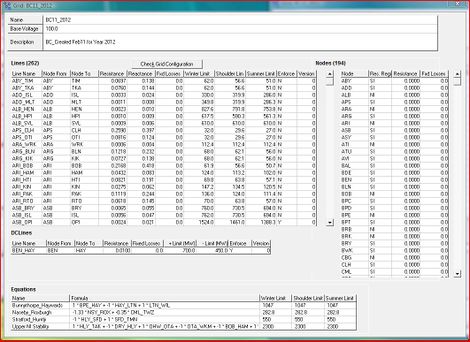EMK:Grid
The Grid is the physical design of the lines and nodes.
The grid is modelled as a single line between nodes, therefore if the physical grid has more than one line, this needs to be reflected in the values associated with the line. The physical aspects of the line, Resistance and Reactance are modelled to determine losses. Lines limits can be applied using 'Enforce' so constraints can be modelled.
Details Box (top of the window)
| Name and Description | Used to identify and describe the Grid Resource |
| Base Voltage | Determines the variable losses that occur on a line through the formula: Loss = RZ2 / Base Voltage, where R is the per unit resistance of a line and Z the power flowing through the line in MW. |
Lines Box
The Grid Lines Box provides access to details of the Lines connecting Nodes on a Grid. Lines can be added to, or removed from, the Grid Instance and their details edited.
Note: Within EMarket positive line flow (Node from to Node to) is an arbitrary convention. EMarket automatically adjusts for line flow direction at run time.
Line Box Fields
| Line Name | Automatically produced from Node From and Node To fields |
| Node From | The code of the Node defined as the upstream Node when line flow is positive |
| Node To | The code of the Node defined as the downstream Node when the line flow is positive |
| Resistance | The per unit resistance of the line |
| Reactance | The per unit reactance of the line |
| Winter Limit (MW) | The maximum capacity of the line during the Winter period |
| Shoulder Limit (MW) | The maximum capacity of the line during the Shoulder period |
| Summer Limit (MW) | The maximum capacity of the line during the Summer period |
| Enforce | When set to Y the Line capacities are enforced during Runs. When set to N, EMarket runs with the Line unconstrained which means that the power flow can exceed the limit values in this table. |
| Version | The line version allows for multiple lines of the same name so could represent lines upgrades or outages. The model defaults to line version 0, with additional version values accessed through the schedule. i.e. Line:WKM_OTA.Version = Timeseries(0,'1/11/2012',1) |
Note: As the Winter, Shoulder and Summer periods vary, they need to be defined within the schedule using the variable 'TransmissionSeason' as the input.
If the seasons are not defined, the model will default to the Winter Season.
DC Lines Box
The Grid DC Lines Box is used to set the limits on DC Lines (principally for the HVDC link).
DC Lines Box Fields (Fields which are identical to the lines box have been omitted)
| +Limit (MW) | The capacity of the line when the power flow is positive |
| -Limit (MW) | The capacity of the line when the power flow is negative |
Note: Lines appearing in the DC Lines Box cannot also appear in the Grid Lines Box. You will be prevented from saving a Grid with Lines duplicated in this manner.
Nodes Box
The Grid Nodes Box contains the Nodes available for connecting the Lines in the Grid and determines the linkage between Node and Reserve Region which is essential for effective Reserves modelling.
Note: Reserves Node-Region mappings should not be confused with the Node-Region mappings (related to Demand) in the Regions Window - they have distinctly different purposes.
Nodes Box Fields
| Node | A code representing a Node on the Grid |
| Region | The Reserve Region where the Node is located. New Reserve Regions can be mapped to Nodes simply by editing their Region field. Note: The Res.Region is used for WV calculations to determine which side of the HVDC a node lies. |
| Resistance | This represents the per unit resistance between the retail supply Nodes and those on the Grid backbone and is used to model transformer losses on aggregated Grids. Full Grid models do not need resistance values, where aggregated grids are used resistance values may be needed to model losses. |
| Fixed losses | A foxed loss in MW can be attributed to this node. |
Equations Box
The Grid Equations Box is used to model Equation Constraints associated with the Grid.
Equation Box Fields
| Name | Used to reference the Constraint in Schedule Resources and Reports |
| Formula | The constraint formula expressed in the same format as used by Transpower.: For the Constraint to be effective the circuits used in the formula must have exact matches in the Grid |
| Winter Limit | The value (as calculated in each Tick using the formula) at which the Constraint will become effective during the Winter period |
| Shoulder Limit | The value (as calculated in each Tick using the formula) at which the Constraint will become effective during the Shoulder period |
| Summer Limit | The value (as calculated in each Tick using the formula) at which the Constraint will become effective during the Summer period |
- Comments
- Nodes need to be present before a line can be entered
- Individual line limits can be modified for defined periods using the schedule
- Individual lines can be entirely 'outaged' through the schedule
- Data can be copied directly from excel cells into cells in EMarket
